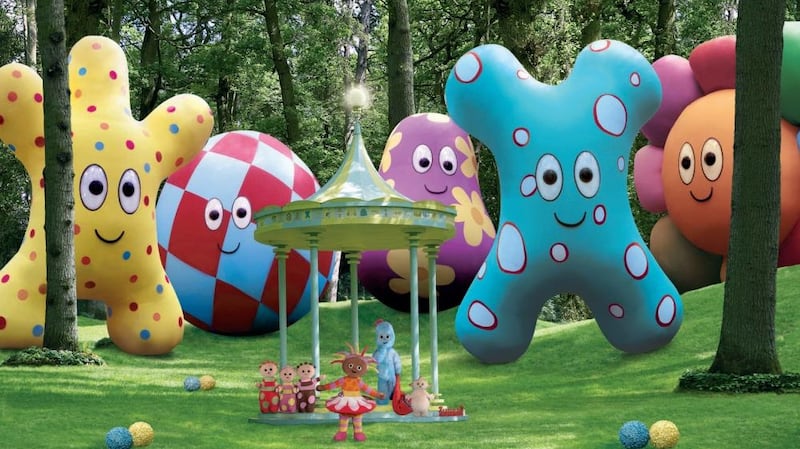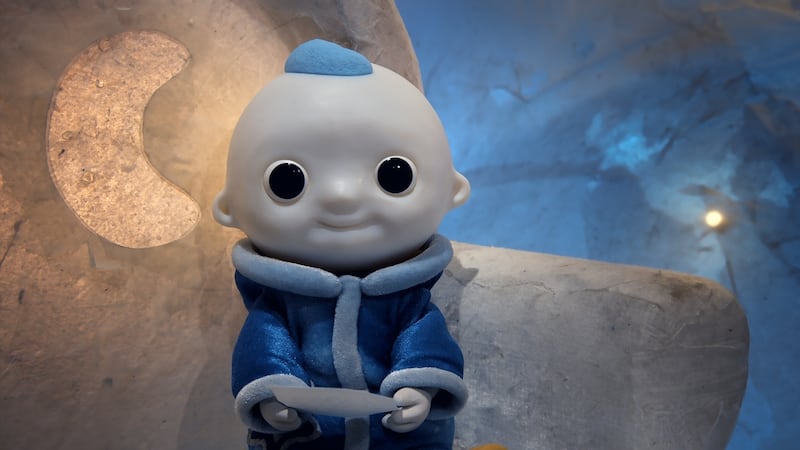We've not even started watching Moon and Me, the new CBeebies show by Teletubbies creator Andrew Davenport, and it's already a hit in our house.
“I need that one! I need that one!” pleads my two-year-old daughter, pointing at a tiny thumbnail image of the show’s characters – Pepi Nana and Moon Baby – while it downloads for our test screening. Before I have time to explain to her once again the difference between “need” and “want” (you need food and oxygen, you only want to throw my umbrella in the bath), she’s dancing to the theme tune, talking to the characters like old friends and marvelling at the huge moon the show revolves around.
Another child transfixed! Just how does Davenport do this? Sadly for those looking for a quick childcare fix, the answer seems to be: incredible instinct and a lot of painstaking research.
For Moon and Me, Davenport (53) teamed up with the University of Sheffield to develop a project in which cameras were set up all over a toy house, so they could observe a day in the life of a toy while they're being played with. "It was like the Big Brother house only with toys," he laughs.
Their spying revealed some interesting findings – a fascination with stairs, and an insistence that there's no better party than a tea party. Such things informed Moon and Me's narrative, which is inspired by the Rumer Godden and Enid Blyton toyhouse stories of the 1930s and 1940s. Pepi Nana is a toy who comes to life whenever the moon comes out (and her owner is asleep). Moon Baby visits them from the moon and, in what some people might deem a rude guest, proceeds to wake the rest of the toyhouse with an African thumb piano. He then guides them to Storyland for a story and a song. The whole thing retains the magical vibe of In the Night Garden, yet has a more traditional and homemade feel.

It's hard to imagine it causing the same uproar Teletubbies did when it arrived in 1997. Back then there were tabloid panics that it was turning toddlers' brains to mush, or that the show contained secret gay messages (Tinky Winky carried – shock! Horror! – a handbag). Locals staged protests. Helicopters would fly over the field in which it was filmed, with photographers onboard hoping to reveal the faces of the actors in the costumes. Visitors to the set had to be blindfolded, for fear they might give away the location.
“We just hadn’t prepared for that kind of interest at all,” says Davenport. “People’s relatives were getting doorstepped, which is a surprising place to be in thanks to a pre-school children’s television programme. And the show took on a meaning of its own in the culture that was a little uncontrollable, which in hindsight was fine, but did mean a lot of things were said about it that weren’t true.”
When Davenport wrote In the Night Garden, a gently psychedelic affair conceived as a way of guiding children to bed, he was braced for more mayhem. But the only drama came when the BBC tried to move the broadcast time – the show was so popular with parents that it had already become an essential part of the bedtime routine.
That hasn’t stopped people projecting wild meanings on to the show. Buzzfeed called it a “surrealist orgy of sex and death”, which seems a bit much given the claim was mainly centred around Upsy Daisy occasionally flashing her knickers. Elsewhere online, someone has constructed an ambitious theory that the show is all a dying hallucination in the mind of Iggle Piggle, who is actually a dehydrated sailor lost at sea. Has Davenport heard that one?
There’s a pause. “Er ... no. In a word. I don’t know whether to look that up or not! But if you worry about stuff like that you’re in the wrong business. People are creative, they write their own jokes and obviously there are readings that are ... less savoury, that I probably wouldn’t want to know about.”

I wonder if the murky world of the internet, which has taken over culture in the 20 years since Teletubbies landed, plays any part in his writing. Davenport says Moon and Me had to be versatile to different formats, and accepts that lots of viewers will be watching on phones and tablets. Teletubbies was actually conceived as a way of helping children understand the new world of screens, but it seems almost quaint compared to the technology today. What does Davenport make of it? "I think it's a double edged sword," he says. "I remember when my godson was younger, the first thing he'd say was 'hello' and then 'can I have the iPad?' and I wouldn't see him again. It did slightly devalue the experience of going to see him."
In a way, Moon and Me is a reaction to such technology – a show about play that doesn't involve screens. "The characters are constantly shown drawing, reading books, painting, making things, doing things with their hands," explains Davenport. "Hands are a big theme of the show. There are over 500 objects in the toy house and every one is handmade, handpainted."
Davenport also banned any computer generated imagery (“quite a fight”), instead turning to puppetry, stop-motion animation and homemade effects. “Children are fascinated by real objects,” he says. “They will be able to see the weave of the fabric, the joins in the wallpaper, the printing on the wallpaper. There’s a joy in seeing the messiness.”
Davenport's background is an arty one: you can see him flinging his limbs around impressively on a Soho roof for Mehdi Norowzian's short film Joy (which "inspired" the famous Guinness advert Anticipation – the whole thing ended up in court). And he was once a model for Gilbert and George, after he heard they were looking for a model with "big eyes". They were paying £30 cash in hand – "which was significant back then" – so he found them in the Yellow Pages under "artists" and gave them a call. George answered, invited him for tea the next day, and he ended up staring out from one their artworks entitled Eyes. "I've never actually seen it in person," he confesses. "But I remember sitting on a train reading a Big Issue feature about them, and suddenly realising that the piece of work I was looking at was me!"
Yet it was his rather less arty degree course in speech sciences that proved the bigger influence on his TV work.
“Back in the early 90s, a lot of teachers had become television makers and there was an emphasis towards schooling,” he says. “Where I came from, the focus was very much on the early years, the first three years of life, where the fundamental processes of becoming human are all happening – learning to speak, learning to walk and crawl. All of that happens in an incredibly short time, which is where my fascination with play comes from. You can largely tell what’s going on by the way a child is playing.”

Davenport's ideas were pretty radical at the time – incorporating the likes of Jean Piaget and Noam Chomsky into his surreal stories – but that didn't stop people criticising Teletubbies. Stephen Byers, the schools minister at the time, even said it represented a "dumbing down" of British culture, due to its supposedly unintelligible language. "I think the rigour in which it was constructed was largely missed," he says.
Even now, Davenport is glad of the chance to explain how much thought goes into his hit shows. Yet despite his slightly terrifying insight into these unknowable little minds, he still gets extremely nervous before any new programme airs.
“The whole thing only comes together fully at the very last minute, so you never really know how it’s going to go down until the audience get to see it.”
Given that every morning since our interview, my daughter has woken up and asked “Where’s Pepi Nana?” repeatedly until we put it on, I think he’s probably going to be okay. – Guardian
Moon and Me starts on CBeebies on February 4th











